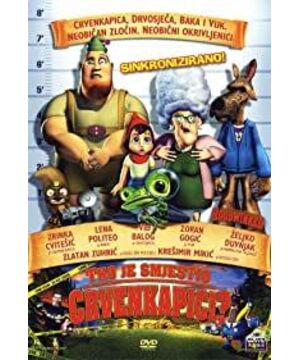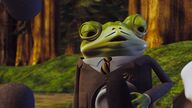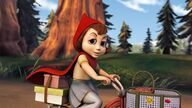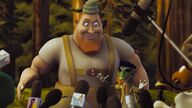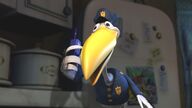The new version of "Little Red Riding Hood" is a postmodern movie full of irony with fairy tales as the theme. The following will compare the new version of "Little Red Riding Hood" with Bello and Green’s version of "Little Red Riding Hood", and analyze its successful subversion of traditional fairy tales from the perspective of character setting, plot arrangement, and aesthetic value. But on the other hand, The post-modern aesthetic method also has its disadvantages to children. Through further analysis, I finally start to think about the "childhood disappearing" in the post-modern context.
Keywords: "Little Red Riding Hood", postmodernist film adaptation, the disappearance of childhood
"Postmodern" has always been a hot topic in academic debates since its emergence. It opposes "anthropocentrism", advocates irrationalism, emphasizes reflection and critical modernity, advocates the pluralism and diversity of the world, and emphasizes pluralistic thinking and openness. and many more. Folk fairy tales that have lasted for a long time are often adapted in the process of spreading. The post-modern version of "Little Red Riding Hood" was put on the screen by Hollywood in 2005. She was produced by an American director. It is a modern anime film. It is very different from the traditionally familiar "Little Red Riding Hood". , Participate in computer production with modern high technology, especially computer technology and sound, light and shadow technology, to form magnificent or thrilling and breathtaking image wonders; use parody, cut and paste, irony and other standard post-modern expressions in the narrative grammar of the film Method: Using a non-linear narrative model in structure, it deconstructs the traditional "Little Red Riding Hood" fairy tale and constructs a new version of the "Little Red Riding Hood" detective story that is quite different from the traditional fairy tale. It is a post-modern movie full of irony with fairy tales as the theme.
1. Version review
(1) Belo's version: "Little Red Riding Hood" by the patriarchal society
In 1697, French writer Charles Perrault published "The Story of Mother Goose or Past Stories with Moral Lessons" in Paris in the name of his youngest son, and included "Little Red Riding Hood". "Little Red Riding Hood" is understood in literary works as the good baby of mother and grandma. The innocent and innocent girl is a delicious food for wolves. The story of "Little Red Riding Hood" teaches children to obey the teachings of their parents to prevent bad guys from taking advantage of it. But in fact, if you read Perot's version of "Little Red Riding Hood" carefully, it is not difficult to find that it has strong sexual hints and at the same time expresses men's requirements for female chastity. As a writer who defended court ethics, the story described by Perot implies that in the 17th century, during the imperial power era, women were the victims of aristocratic marriages as an exchange asset. In this context, the story of "Little Red Riding Hood" contradictoryly simultaneously appears sexual cues and moral warnings, implying the importance of chastity. Here, Little Red Riding Hood acts as a warning character, meaning "If you don't keep your chastity, you will definitely be eaten by a wolf."
(2) Green's version: "Little Red Riding Hood" for the middle class
With the development of the Industrial Revolution in the 19th century, the German middle class continued to grow and grow. Coupled with the emergence of the concept of "childhood", the unique characteristics and needs of childhood were gradually recognized, and middle-class families began to pay more attention to children's education. In order to meet the needs of middle-class ethics, the fairy tales of the Brothers Grimm have been repeatedly modified and deleted in multiple versions. In addition, according to Piaget's theory of stages of moral development, the good and bad people in fairy tales will have different moral influences on them. Children's immature moral judgment ability requires that the fairy tales written for them must be clear between good and bad people, and the final outcome must be that good is rewarded, and evil is rewarded. In view of the above reasons, there is a big difference in plot arrangement between Brothers Grimm's "Little Red Riding Hood" and Perot's "Little Red Riding Hood": At the end of the story, the big bad wolf is subdued by the hunter, and Little Red Riding Hood is rescued, crying and regretting that he should not walk into the road. , I promise I never dare to be so disobedient again. At this point, "Little Red Riding Hood" has conveyed a popular lesson: to behave well and not to talk to strangers [1].
(3) Movie version: Postmodernist "Little Red Riding Hood"
The new version of "Little Red Riding Hood" tells the unknown story behind the fairy tale: Sheriff Grizzly and Detective Stork Bill were ordered to investigate the internal disturbances that occurred in the grandmother's cabin. Many people were accused of criminal acts by the police. The persons involved included karate masters. Little Red Riding Hood, Da Hui, a funny and ironic reporter, a resident of a strong and stupid woods, etc. They were charged with multiple crimes, including: sabotage and illegal invasion, undermining social stability, illegal eating, using an axe without a license, and so on. However, all these extraordinary suspects accused have their own stories to tell. In addition, this case is likely to be related to a mysterious "candy thief" who stole recipes from various candy shops everywhere. After some twists and turns, with the help of Detective Frog, the truth finally came to light. The weak and cute rabbit in everyone's eyes turned out to be the "Candy Thief" in the quake-hit forest.
2. Subversive character setting
There are animated characters in every cartoon, which is indispensable and the soul of the cartoon. The post-modern version of "Little Red Riding Hood" overturns and decomposes the traditional thinking model. It looks like this, but the facts are contrary to it; it obscures the opposing concepts in the animation, such as wolf and grandmother, wolf and hunter. , Expressing a spirit that is perfectly different from the classic tradition, this is a subversive role.
In the traditional fairy tales of the Belo and Grimm brothers, wolves are usually evil, heroes are usually strong, and old and weak women and children are generally protected objects. Postmodern fairy tales look at this phenomenon from multiple angles, and sometimes there is even a strong contrast between characters and images. The new version of "Little Red Riding Hood" subverts the heroic image of the hunter and the negative role of the big bad wolf. Different from the previous symbol of wisdom and strength, the hunter in the new version of "Little Red Riding Hood" is a stupid man with a strong appearance, chanting a few ridiculous lines upside down; instead of cutting the wood, he is chased by the trees he fell, making people chase. Can not help but can not help; when he appeared at the scene of the crime, he was relegated from a hero to an intruder who entered with a knife and recklessly. The other protagonist of the story, Big Bad Wolf, has changed from a cunning and vicious negative role to a dedicated reporter, risking his life in order to dig up the news. In the story, he spent a full 6 months investigating the whereabouts of the Candy Thief. He also used a lot of money to buy information from intelligence agents who were dressed as sheep.
But in the new version of "Little Red Riding Hood", whether it is the hunter hero transitioned from the traditional fairy tale, or the big bad wolf hero constructed in the new fairy tale, they are vulnerable and lack wisdom. They have dedication, but they are not selfless. They are individuals with desires and defects. Their heroic behavior may be due to coincidence or other purposes, and the myth of heroes is dispelled here. "Little Red Riding Hood" jokingly erased the halo from the heroes, restoring their secular and figurative side.
The new version of Little Red Riding Hood is different from the traditional image of an obedient girl. She has a heroic side: she has won many karate championships and caught big men like the big bad wolf; she escorted the secret recipe of candy to the forest and found that the candy thief was also calm. Calm, sneak into the enemy camp alone. She has the side of the only child in the family: she is self-willed, self-sufficient, independent, and independent. When faced with the big bad wolf to test whether she is a candy thief, she is skeptical of the big bad wolf; facing the interrogation of the inspector frog" Why do they call you by this name?" She did not answer politely, but retorted: "Why do they call you Flippers?" The Detective Frog was speechless. From the traditional image of an obedient girl to the rich post-modern image of children, the image of Little Red Riding Hood can be described as a world of difference.
The postmodern image of the grandmother in the new version of "Little Red Riding Hood" overturns the traditional image of a woman more thoroughly. Grandma is no longer a typical example of the previous version of sickness and powerlessness. She is vigorous and adventurous like a young man. Although she loved her granddaughter, she made concessions in the face of her personality and free life. The visit to his granddaughter seems to be a very happy and important thing for an ordinary old man, but she repeatedly evaded it because of the extreme competition. She is no longer a traditional old man who stays at home and has only children and grandchildren in her life and emotions. She has a bunch of young friends of her own, and she also has a "GGG" tattoo on her body. Her life is full of vigor and excitement, skiing, surfing, and mountain climbing are all available.
The Candy Thief Bunny looks weak, but the dexterous bunny ears are powerful weapons. It is also a hypocrite image that is different from the pure villain of traditional fairy tales. The liar is not only the little rabbit but also the grandmother of Little Red Riding Hood. This kind of deception caused by family trust has a greater impact. These completely different images are the subversion and supplement of the traditional fairy tale image, and are of great significance to enrich the fairy tale character image gallery. They and the traditional fairy tale image have their own value.
It must be noted that although the subversive character satisfies the audience's visual stimulation to a certain extent, it relaxes the audience's spirit and gains happiness; at the same time, it provides help to the development of animation diversification. However, once the classic works are deeply hollowed out, the value of the animation itself will be lost, people's judgment on the values of good and evil, beauty and ugliness will be blurred, and even social culture will be vulgarized. Therefore, animation creators must carefully analyze the connotation expressed by classic animation, and when creating disruptive characters, they must not only make them have profound educational significance, but also become classics once again. 【2】
Third, the uniqueness of plot arrangement
The beginning of the fairy tale tells you that this is not the Grimm fairy tale you know: "You may know the story of Little Red Riding Hood, but what you know is not the whole story", making you doubt the familiar traditional fairy tale. After entering the fairy tale, the people in the story are also given modern occupations and titles. For example, Little Red Riding Hood is a master of karate, Big Bad Wolf is a reporter, hunter is an actor, and the old grandmother has become an adventurer, nostalgic for skiing, surfing, and mountaineering. Waiting for the modern movement.
The new version of "Little Red Riding Hood" set up suspense at the beginning, such as the candy thieves out of the forest. Who is this mysterious thief? The four suspects hold their own words. Who is lying? Or no one lied, there is a fifth person hiding in the dark? As the story unfolds, Mystery Cloud is revealed bit by bit, and in the end it turns out to be a soft, cute and cute little rabbit. This narrative method that uses reasoning and suspense arouses the desire of the audience to continue watching, making the film rich in drama and fascinating.
The use of intertext and irony makes the storyline richer. In the postmodern version of "Little Red Riding Hood", irony is embodied in the playful interaction between traditional fairy tales and modern fairy tales. For example, a hunter broke into a house in danger, but he changed from a traditional hero to an illegal intruder who used an axe without a license, but at the end of the fairy tale he restored his "hero" status, and he too One of the heroes who caught the Candy Thief. It's just that the title of "hero" is somewhat embarrassing. At the same time, the fairy tale adopted a parody approach. The classic cartoon image of The Three Little Pigs once again participated in a cameo performance. This time they became police officers in the police station. They spoke loudly, loved to gossip, and liked to play. Playing cards and eating candies, and built a house with straw. In addition, the setting of wolf and detective stories in sheep's clothing also constitutes intertextuality with some traditional texts. 【3】
Fourth, the gains and losses of aesthetic value
(1) Discover children and pay attention to the catharsis of children's emotions and hearts
The traditional fairy tale "Little Red Riding Hood" is a fairy tale with a moralistic tendency. It teaches children to listen to their parents and be a good child so as not to go astray. This kind of restraint brings various spiritual scars to the child. In the new version of "Little Red Riding Hood", Little Red Riding Hood questioned her grandmother, "You are living a crazy life, but I want to stay at home and be your delivery girl happily", which accuses the doctrine of the restraint and suppression of children's personality. Grandma's answer "I thought you were very happy" shows that adults always examine children's emotions from their own perspective, and arrange children's lives according to their own needs, ignoring children's feelings as an independent subject. In the postmodern version of "Little Red Riding Hood", Little Red Riding Hood has a strong sense of personality, and even her grandmother has to admit: "It seems that I have been neglecting you to grow so fast." In short, the new version of "Little Red Riding Hood" discovers children in a sense , Instead of treating him as an accessory for adults. 【4】
(2) Exaggerated humor, full of suspense, vivid and three-dimensional characterization
The use of reasoning and suspenseful narrative methods arouses the audience's desire to continue watching, giving the film a strong dramatic color. The language of the new version of "Little Red Riding Hood" conforms to the character image, exaggerated, humorous, and imaginative. Little squirrel's language is lively and impatient, Little Red Riding Hood's language has the arrogance and willfulness of modern girls, and the hunter's language is more stupid. In the play, the goat is enchanted to sing, the squirrel eats the camera, and the big bad wolf is the offspring of a dog raised up by the wolf. The plot is also nonsensical and funny.
(3) Not conducive to cultivating children's simple outlook on nature
The new version of "Little Red Riding Hood" has some aesthetic misunderstandings brought about by postmodernism. On the one hand, although the new version of "Little Red Riding Hood" is full of innovative significance for the transformation of the forest, it is full of imagination, but this innovation also weakens the natural beauty brought by the forest, which is useful for cultivating children's simple aesthetic awareness of nature. Adverse. The new version of "Little Red Riding Hood" is a story that takes place in the forest, that is, a story that takes place in nature, but the intrusion of modern civilization makes people unable to feel the strong natural atmosphere. Little Red Riding Hood riding a bicycle in the forest, the taxi hired by the old wolf with a wave of his hand, the unobstructed police car, and the rugged and narrow paths in the forest seem to have become spacious and flat roads, all of which have destroyed the peaceful and harmonious beauty of the forest. Piaget believes that the most prominent feature of children is the tendency of "animism", that is, a tendency to regard all things as things with life and images. But in the new version of "Little Red Riding Hood", the relationship between man and nature is indifferent (such as cutting trees, building large-scale modern factories in the forest, etc.), and nature exists as a lifeless objective environment. 【5】
(4) Some details are dealt with without mental considerations
As a fairy tale art, we hope that the post-modern version of "Little Red Riding Hood" can become a contemporary classic and leave beautiful memories in the children's childhood. However, some details lack the consideration of humanistic spirit, which is a bit regrettable. For example, there is a candy thieves in the forest, and everyone is worried about their own interests. There is not a single worry: if there is no candy, the citizens in the forest, especially the children, will not taste the sweet taste. The police in the forest also lack the strong sense of mission like the black cat sheriff—maintain forest order and protect forest citizens. They are upright and full of justice. They are three little pig-like police officers who can only eat, drink and play cards. Although this kind of character image satisfies the temporary audiovisual entertainment, it is not good for the child's long-term aesthetic feeling and the formation of a healthy personality. They will make their children misunderstand the profession of the police, thinking that the police are like three little pigs and they are lazy. Of course, police officers like the Three Little Pigs also exist in real life. They can appear in adult film novels as critical roles, but they are not suitable for appearing in fairy tales, and they are deliberately exaggerated, because children's judgments of right and non-value It has not been fully formed yet, and can only passively accept the negative information conveyed in fairy tales.
In short, postmodernism's innovations in form and content can attract children's attention, and lively character images and narrative modes make children's childhood more fun. However, if postmodernism can not grasp the degree of subversion of fairy tales, it will affect the formation of children's positive and healthy outlook on life and values. 【6】
View more about Hoodwinked reviews


